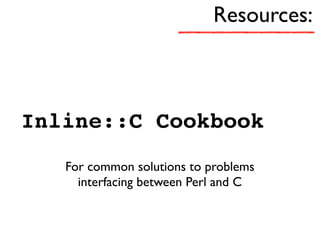Ad
The Perl API for the Mortally Terrified (beta)
- 1. The Perl API for the Mortally Terrified Mike Friedman (friedo) London Perl Workshop November 30, 2013
- 4. This talk is the product of a lengthy journey.
- 5. This talk is the product of a lengthy journey. It's also a work in progress.
- 6. I have some limited experience in integrating Perl and C with XS, and would enjoy the opportunity to expand my skills in this area.
- 7. i R dum.
- 9. - Learned from this book.
- 10. - Learned from this book. - It’s very good
- 11. - Learned from this book. - It’s very good - The printing I got was messed up.
- 12. - Learned from this book. - It’s very good - The printing I got was messed up. - Like every " was replaced by ©
- 13. The Perl API What’s it good for? Make things fast:
- 14. The Perl API What’s it good for? Make things fast: - Write your slow Perl code in C
- 15. The Perl API What’s it good for? Make things fast: - Write your slow Perl code in C - Keep your fast Perl code in Perl
- 16. The Perl API What’s it good for? Make Perl more useful:
- 17. The Perl API What’s it good for? Make Perl more useful: - Interface with libraries written in C
- 18. The Perl API What’s it good for? Make Perl more useful: - Interface with libraries written in C - Create modules exposing external APIs to Perl
- 19. The Perl API What’s it good for? Make Perl do...stuff
- 20. The Perl API What’s it good for? Make Perl do...stuff - Change opcodes on the fly?
- 21. The Perl API What’s it good for? Make Perl do...stuff - Change opcodes on the fly? - Extend the parser?
- 22. The Perl API What’s it good for? Make Perl do...stuff - Change opcodes on the fly? - Extend the parser? - Make exceptions work?
- 23. The Perl API What’s it good for? Make Perl do...stuff - Change opcodes on the fly? - Extend the parser? - Make exceptions work? - Why not?
- 24. The Perl API What’s it good for? Make Perl do...stuff - Change opcodes on the fly? - Extend the parser? - Make exceptions work? - Why not?
- 25. A Crash Course in C
- 26. C Crash Course Basic Types (there are more)
- 27. C Crash Course Basic Types (there are more) char foo = ‘a’;
- 28. C Crash Course Basic Types (there are more) char int foo bar = ‘a’; = 42;
- 29. C Crash Course Basic Types (there are more) char int long foo bar baz = ‘a’; = 42; = 198547;
- 30. C Crash Course Basic Types (there are more) char int long float foo bar baz quux = = = = ‘a’; 42; 198547; 3.14159;
- 31. C Crash Course Basic Types (there are more) char int long float double foo bar baz quux splat = = = = = ‘a’; 42; 198547; 3.14159; 3.14159265358979;
- 33. C Crash Course Pointers char *foo; /* ptr to char */
- 34. C Crash Course Pointers char int *foo; *bar; /* ptr to char /* ptr to int */ */
- 35. C Crash Course Pointers char int long *foo; *bar; *baz; /* ptr to char /* ptr to int /* ptr to long */ */ */
- 39. C Crash Course Pointers are integer variables which hold a memory address.
- 41. C Crash Course C int i Perl = 42; my $i = 42;
- 42. C Crash Course C int i = 42; int *i_ptr = &i; Perl my $i = 42; my $i_ref = $i;
- 43. C Crash Course C Perl int i = 42; my $i = 42; int *i_ptr = &i; my $i_ref = $i; Read unary & as “address-of.”
- 44. C Crash Course C Perl int i = 42; my $i = 42; int *i_ptr = &i; my $i_ref = $i; Read unary & as “address-of.” int j; my $j;
- 45. C Crash Course C Perl int i = 42; my $i = 42; int *i_ptr = &i; my $i_ref = $i; Read unary & as “address-of.” int j; j = *i_ptr; my $j; $j = $$i_ref;
- 46. C Crash Course C Perl int i = 42; my $i = 42; int *i_ptr = &i; my $i_ref = $i; Read unary & as “address-of.” int j; j = *i_ptr; my $j; $j = $$i_ref; Read unary * as “dereference.”
- 48. C Crash Course Aggregates int foo[10]; /* array of ints */
- 49. C Crash Course Aggregates int float foo[10]; bar[12]; /* array of ints */ /* array of floats */
- 50. C Crash Course Aggregates int float char foo[10]; bar[12]; baz[42]; /* array of ints */ /* array of floats */ /* a string! */
- 52. C Crash Course Aggregates struct person { int age; char *name; double acct_balance; };
- 53. C Crash Course Aggregates struct person { int age; char *name; double acct_balance; }; age *name acct_balance ...
- 55. C Crash Course Aggregates union thingy { long num; char chars[4]; foo_t *myfoo; };
- 56. C Crash Course Aggregates union thingy { long num; char chars[4]; foo_t *myfoo; }; thingy.num thingy.chars thingy.myfoo f3 de 42 9a
- 57. C Crash Course Using structs
- 58. C Crash Course Using structs struct person the_dude; the_dude.age = 42; the_dude.name = “jeffrey lebowski”; the_dude.acct_balance = 1.79;
- 59. C Crash Course Using structs struct person the_dude; the_dude.age = 42; the_dude.name = “jeffrey lebowski”; the_dude.acct_balance = 1.79; 00 2a age 3f 39 d2 90 a4 70 3d *name 0a d7 a3 fc acct_balance j e f f r e y ... 3f
- 60. C Crash Course Typedefs typedef struct { int age; char *name; double acct_balance; } person; person the_dude;
- 61. XS
- 62. What is XS? perldoc perlxs: XS is an interface description file format used to create an extension interface between Perl and C code (or a C library) which one wishes to use with Perl. The XS interface is combined with the library to create a new library which can then be either dynamically loaded or statically linked into perl. The XS interface description is written in the XS language and is the core component of the Perl extension interface.
- 64. XS is a specialized templating language for C.
- 65. Some XS Code
- 66. Some XS Code This stuff is XS.
- 67. Some C Code made by xsubpp
- 68. XS != Perl API
- 69. For most things
- 70. For most things You don't actually have to use XS.
- 71. (OK.You don’t have to know that you’re using it.)
- 72. Inline::C
- 73. use Inline C; hello('Mike'); hello('Cookie Monster'); __END__ __C__ void hello(char* name) { printf("Hello %s!n", name); }
- 74. use Inline C; hello('Mike'); hello('Grover'); __END__ __C__ void hello(char* name) { printf("Hello %s!n", name); }
- 75. use Inline C; hello('Mike'); hello('Grover'); __END__ __C__ void hello(char* name) { printf("Hello %s!n", name); }
- 76. use Inline C; hello('Mike'); hello('Grover'); __END__ __C__ void hello(char* name) { printf("Hello %s!n", name); }
- 77. Inline::C Code in Perl
- 78. Inline::C Code in Perl Digest::MD5
- 79. Inline::C Code in Perl Digest::MD5 C Code Parse::RecDescent
- 80. Inline::C Code in Perl Digest::MD5 C Code Parse::RecDescent Create build in a temp dir
- 81. Inline::C Code in Perl Digest::MD5 C Code Parse::RecDescent Create build in a temp dir Write XS
- 82. Inline::C Code in Perl Digest::MD5 C Code Parse::RecDescent Create build in a temp dir Write XS Compile and install
- 83. Inline::C Code in Perl Digest::MD5 C Code Parse::RecDescent Create build in a temp dir Write XS Compile and install
- 84. How do we make Perl do stuff in C?
- 85. How do we make Perl do stuff in C? We need to understand Perl’s data structures.
- 86. Handwaving Ahead
- 87. A $scalar in Perl is represented by a struct called SV. SvNULL SvRV SvPV SvIV (These are not all of them.) SvNV
- 88. What does SV look like? sv_refcnt sv_flags { sv_any flags type
- 89. What does SV look like? sv_refcnt sv_flags { sv_any flags type If this scalar is undef, then sv_any is NULL
- 90. What does SvPV (a string) look like? sv_any sv_refcnt sv_flags pvx current len alloc len SV xpv char* a s t r i n g 0
- 91. What do SvIV and SvNV look like? sv_any sv_refcnt sv_flags pvx current len alloc len SV xpviv 69 7a 00 00 ivx char* 3 1 3 3 7 0
- 92. What do SvIV and SvNV look like? sv_any sv_refcnt sv_flags pvx current len alloc len SV xpvnv 6e 86 1b f0 f9 ivx char* 3 . 21 09 40 nvx 1 4 1 5 9 0
- 95. #!/usr/bin/env perl use strict; use warnings; use Inline 'C'; print 'Give me a number: '; my $num_a = <STDIN>; print 'Give me another number: '; my $num_b = <STDIN>; printf "The sum is: %sn", add( $num_a, $num_b ); __END__ __C__ int add( int a, int b ) { return a + b; }
- 96. #!/usr/bin/env perl use strict; use warnings; use Inline 'C'; print 'Give me a number: '; my $num_a = <STDIN>; print 'Give me another number: '; my $num_b = <STDIN>; printf "The sum is: %sn", add( $num_a, $num_b ); __END__ __C__ int add( int a, int b ) { return a + b; }
- 97. #!/usr/bin/env perl use strict; use warnings; use Inline 'C'; print 'Give me a number: '; my $num_a = <STDIN>; print 'Give me another number: '; my $num_b = <STDIN>; printf "The sum is: %sn", add( $num_a, $num_b ); __END__ __C__ int add( int a, int b ) { return a + b; }
- 98. #!/usr/bin/env perl use strict; use warnings; use Inline 'C'; print 'Give me a number: '; my $num_a = <STDIN>; print 'Give me another number: '; my $num_b = <STDIN>; printf "The sum is: %sn", add( $num_a, $num_b ); __END__ __C__ int add( int a, int b ) { return a + b; }
- 99. #!/usr/bin/env perl use strict; use warnings; use Inline 'C'; print 'Give me a number: '; my $num_a = <STDIN>; print 'Give me another number: '; my $num_b = <STDIN>; printf "The sum is: %sn", add( $num_a, $num_b ); __END__ __C__ int add( int a, int b ) { return a + b; }
- 100. #!/usr/bin/env perl use strict; use warnings; use Inline 'C'; print 'Give me a number: '; my $num_a = <STDIN>; print 'Give me another number: '; my $num_b = <STDIN>; printf "The sum is: %sn", add( $num_a, $num_b ); __END__ __C__ int add( int a, int b ) { return a + b; }
- 101. Run it! bash-3.2$ perl cexp1.pl Give me a number: 42 Give me another number: 11 The sum is: 53
- 102. Run it again! bash-3.2$ perl cexp1.pl Give me a number: 42 Give me another number: 31.337 The sum is: 73
- 103. Run it again! bash-3.2$ perl cexp1.pl Give me a number: 42 Give me another number: 31.337 The sum is: 73 What happened?
- 106. use Inline 'C'; print 'Give me a number: '; my $num_a = <STDIN>; print 'Give me another number: '; my $num_b = <STDIN>; $num_a += 0; $num_b += 0; printf "The sum is: %sn", add( $num_a, $num_b ); __END__ __C__ SV *add( SV *a, SV *b ) { if ( SvIOK( a ) && SvIOK( b ) ) { return newSViv( SvIV( a ) + SvIV( b ) ); } else if ( SvNOK( a ) && SvNOK( b ) ) { return newSVnv( SvNV( a ) + SvNV( b ) ); } else { croak( "I don't know what to do!" ); } }
- 107. use Inline 'C'; print 'Give me a number: '; my $num_a = <STDIN>; print 'Give me another number: '; my $num_b = <STDIN>; $num_a += 0; $num_b += 0; printf "The sum is: %sn", add( $num_a, $num_b ); __END__ __C__ SV *add( SV *a, SV *b ) { if ( SvIOK( a ) && SvIOK( b ) ) { return newSViv( SvIV( a ) + SvIV( b ) ); } else if ( SvNOK( a ) && SvNOK( b ) ) { return newSVnv( SvNV( a ) + SvNV( b ) ); } else { croak( "I don't know what to do!" ); } }
- 108. use Inline 'C'; print 'Give me a number: '; my $num_a = <STDIN>; print 'Give me another number: '; my $num_b = <STDIN>; $num_a += 0; $num_b += 0; printf "The sum is: %sn", add( $num_a, $num_b ); __END__ __C__ SV *add( SV *a, SV *b ) { if ( SvIOK( a ) && SvIOK( b ) ) { return newSViv( SvIV( a ) + SvIV( b ) ); } else if ( SvNOK( a ) && SvNOK( b ) ) { return newSVnv( SvNV( a ) + SvNV( b ) ); } else { croak( "I don't know what to do!" ); } }
- 109. use Inline 'C'; print 'Give me a number: '; my $num_a = <STDIN>; print 'Give me another number: '; my $num_b = <STDIN>; $num_a += 0; $num_b += 0; printf "The sum is: %sn", add( $num_a, $num_b ); __END__ __C__ SV *add( SV *a, SV *b ) { if ( SvIOK( a ) && SvIOK( b ) ) { return newSViv( SvIV( a ) + SvIV( b ) ); } else if ( SvNOK( a ) && SvNOK( b ) ) { return newSVnv( SvNV( a ) + SvNV( b ) ); } else { croak( "I don't know what to do!" ); } }
- 110. Run it! bash-3.2$ perl cexp2.pl Give me a number: 42 Give me another number: 11 The sum is: 53 bash-3.2$ perl cexp2.pl
- 111. Run it! bash-3.2$ perl cexp2.pl Give me a number: 42 Give me another number: 11 The sum is: 53 bash-3.2$ perl cexp2.pl bash-3.2$ perl cexp2.pl Give me a number: 53.4 Give me another number: 6.54 The sum is: 59.94
- 112. Run it! bash-3.2$ perl cexp2.pl Give me a number: 42 Give me another number: 11 The sum is: 53 bash-3.2$ perl cexp2.pl bash-3.2$ perl cexp2.pl Give me a number: 53.4 Give me another number: 6.54 The sum is: 59.94 Give me a number: 42 Give me another number: 6.54 I don't know what to do! at cexp2.pl line 16, <STDIN> line 2.
- 113. Once you get this far, everything you need is in perlapi.
- 114. Let's do something with arrays.
- 115. What does an AV look like? sv_any sv_refcnt sv_flags array fill max SV xpvav *some fields omitted alloc array len SV SV*[] SV ... ...
- 116. #!/usr/bin/env perl use strict; use warnings; use Inline 'C'; print "Give me some numbers: "; my @numbers = map { $_ += 0 } split /,/, <STDIN>; my $result = squares( @numbers ); printf "The squares are: %sn", join ", ", @$result; __END__
- 117. #!/usr/bin/env perl use strict; use warnings; use Inline 'C'; print "Give me some numbers: "; my @numbers = map { $_ += 0 } split /,/, <STDIN>; my $result = squares( @numbers ); printf "The squares are: %sn", join ", ", @$result; __END__
- 118. SV *squares( SV *numbers ) { AV *array = (AV *)SvRV( numbers ); AV *return_array = newAV(); SV **tmp; int len = AvFILL( array ); int i, val; for( i = 0; i <= len; i++ ) { tmp = av_fetch( array, i, 1 ); if( !SvIOK( *tmp ) ) { croak( "Can't handle this value!" ); } val = SvIV( *tmp ); val = val * val; av_push( return_array, newSViv( val ) ); } return newRV_inc( (SV *)return_array ); }
- 119. SV *squares( SV *numbers ) { AV *array = (AV *)SvRV( numbers ); AV *return_array = newAV(); SV **tmp; int len = AvFILL( array ); int i, val; for( i = 0; i <= len; i++ ) { tmp = av_fetch( array, i, 1 ); if( !SvIOK( *tmp ) ) { croak( "Can't handle this value!" ); } val = SvIV( *tmp ); val = val * val; av_push( return_array, newSViv( val ) ); } return newRV_inc( (SV *)return_array ); }
- 120. SV *squares( SV *numbers ) { AV *array = (AV *)SvRV( numbers ); AV *return_array = newAV(); SV **tmp; int len = AvFILL( array ); int i, val; for( i = 0; i <= len; i++ ) { tmp = av_fetch( array, i, 1 ); if( !SvIOK( *tmp ) ) { croak( "Can't handle this value!" ); } val = SvIV( *tmp ); val = val * val; av_push( return_array, newSViv( val ) ); } return newRV_inc( (SV *)return_array ); }
- 121. SV *squares( SV *numbers ) { AV *array = (AV *)SvRV( numbers ); AV *return_array = newAV(); SV **tmp; int len = AvFILL( array ); int i, val; for( i = 0; i <= len; i++ ) { tmp = av_fetch( array, i, 1 ); if( !SvIOK( *tmp ) ) { croak( "Can't handle this value!" ); } val = SvIV( *tmp ); val = val * val; av_push( return_array, newSViv( val ) ); } return newRV_inc( (SV *)return_array ); }
- 122. SV *squares( SV *numbers ) { AV *array = (AV *)SvRV( numbers ); AV *return_array = newAV(); SV **tmp; int len = AvFILL( array ); int i, val; for( i = 0; i <= len; i++ ) { tmp = av_fetch( array, i, 1 ); if( !SvIOK( *tmp ) ) { croak( "Can't handle this value!" ); } val = SvIV( *tmp ); val = val * val; av_push( return_array, newSViv( val ) ); } return newRV_inc( (SV *)return_array ); }
- 123. SV *squares( SV *numbers ) { AV *array = (AV *)SvRV( numbers ); AV *return_array = newAV(); SV **tmp; int len = AvFILL( array ); int i, val; for( i = 0; i <= len; i++ ) { tmp = av_fetch( array, i, 1 ); if( !SvIOK( *tmp ) ) { croak( "Can't handle this value!" ); } val = SvIV( *tmp ); val = val * val; av_push( return_array, newSViv( val ) ); } return newRV_inc( (SV *)return_array ); }
- 124. SV *squares( SV *numbers ) { AV *array = (AV *)SvRV( numbers ); AV *return_array = newAV(); SV **tmp; int len = AvFILL( array ); int i, val; for( i = 0; i <= len; i++ ) { tmp = av_fetch( array, i, 1 ); if( !SvIOK( *tmp ) ) { croak( "Can't handle this value!" ); } val = SvIV( *tmp ); val = val * val; av_push( return_array, newSViv( val ) ); } return newRV_noinc( (SV *)return_array ); }
- 125. Run it! bash-3.2$ perl cexp3.pl Give me some numbers: 4,5,6,23 The squares are: 16, 25, 36, 529
- 126. Let's do something with hashes.
- 127. What does an HV look like?
- 128. What does an HV look like? (Diagram missing
- 129. What does an HV look like? (Diagram missing (So I stole this one))
- 130. What does an HV look like? (Diagram missing (So I stole this one))
- 131. #!/usr/bin/env perl use strict; use warnings; use Inline 'C'; print "Give me some words: "; my @words = split /,/, <STDIN>; chomp @words; my $result = uniques( @words ); printf "The uniques are: %sn", join ", ", %$result; __END__
- 132. __C__ SV *uniques( SV *words ) { AV *array = (AV *)SvRV( words ); HV *result = newHV(); SV **tmp; int len = AvFILL( array ); int i; char *val; for( i = 0; i <= len; i++ ) { tmp = av_fetch( array, i, 1 ); if( !SvPOK( *tmp ) ) { croak( "Can't handle this value!" ); } val = SvPV_nolen( *tmp ); hv_store( result, val, strlen( val ), newSV(0), 0 ); } return newRV_noinc( (SV *)result ); }
- 133. Run it! bash-3.2$ perl cexp4.pl Give me some words: foo,bar,baz,baz,foo,quux,narf,poit The uniques are: bar, narf, baz, poit, quux, foo
- 134. What is Magic?
- 135. Not that terrifying.
- 136. Not that terrifying. (code sample missing)
- 137. Magic is a linked list of function pointers attached to a *SV.
- 138. Magic is a linked list of function pointers attached to a *SV. The functions implement custom read/write behavior.
- 139. Magic is a linked list of function pointers attached to a *SV. The functions implement custom read/write behavior. Special vars like %ENV are implemented via Magic.
- 140. $ENV{foo} = "blah";
- 141. $ENV{foo} = "blah"; assignment op
- 142. $ENV{foo} = "blah"; assignment op Magic on %ENV ?
- 143. $ENV{foo} = "blah"; assignment op Magic on %ENV ? Look up write function
- 144. $ENV{foo} = "blah"; assignment op Magic on %ENV ? Look up write function call libc setenv()
- 145. tie() is also implemented via Magic.
- 146. Terror defeated!
- 147. Where do we go from here?
- 148. Resources: perlguts For details on how to manipulate Perl's data structures.
- 149. Resources: perlapi For a comprehensive reference to (almost) everything you need to make perl do stuff.
- 150. Resources: Perlguts Illustrated For pretty diagrams and explication.
- 151. Resources: Inline::C Cookbook For common solutions to problems interfacing between Perl and C
- 152. Resources:
- 154. London Perl Workshop Thank you. Mike Friedman [email protected] http://friedo.com/ http://github.com/friedo/perl-api-terror


























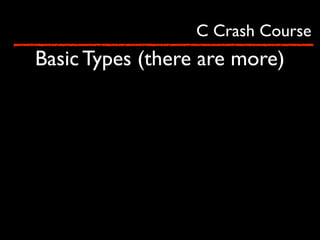





















![C Crash Course
Aggregates
int
foo[10];
/* array of ints */](https://image.slidesharecdn.com/perlapiforthemortallyterrifiedbeta-131202145720-phpapp02/85/The-Perl-API-for-the-Mortally-Terrified-beta-48-320.jpg)
![C Crash Course
Aggregates
int
float
foo[10];
bar[12];
/* array of ints */
/* array of floats */](https://image.slidesharecdn.com/perlapiforthemortallyterrifiedbeta-131202145720-phpapp02/85/The-Perl-API-for-the-Mortally-Terrified-beta-49-320.jpg)
![C Crash Course
Aggregates
int
float
char
foo[10];
bar[12];
baz[42];
/* array of ints */
/* array of floats */
/* a string! */](https://image.slidesharecdn.com/perlapiforthemortallyterrifiedbeta-131202145720-phpapp02/85/The-Perl-API-for-the-Mortally-Terrified-beta-50-320.jpg)




![C Crash Course
Aggregates
union thingy {
long num;
char chars[4];
foo_t *myfoo;
};](https://image.slidesharecdn.com/perlapiforthemortallyterrifiedbeta-131202145720-phpapp02/85/The-Perl-API-for-the-Mortally-Terrified-beta-55-320.jpg)
![C Crash Course
Aggregates
union thingy {
long num;
char chars[4];
foo_t *myfoo;
};
thingy.num
thingy.chars
thingy.myfoo
f3
de
42
9a](https://image.slidesharecdn.com/perlapiforthemortallyterrifiedbeta-131202145720-phpapp02/85/The-Perl-API-for-the-Mortally-Terrified-beta-56-320.jpg)



















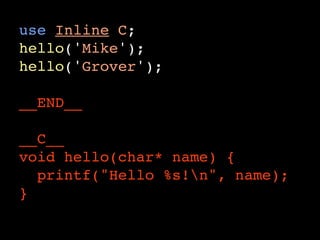





























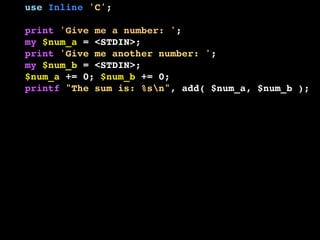


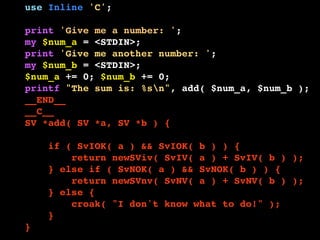





![What does an AV look like?
sv_any
sv_refcnt
sv_flags
array
fill
max
SV
xpvav
*some fields omitted
alloc
array len
SV
SV*[]
SV
...
...](https://image.slidesharecdn.com/perlapiforthemortallyterrifiedbeta-131202145720-phpapp02/85/The-Perl-API-for-the-Mortally-Terrified-beta-115-320.jpg)



































